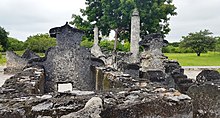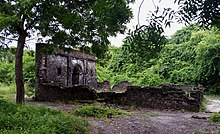Kaole
| Coordinates | 6°27′48″S 38°56′48″E / 6.4634°S 38.9468°E |
|---|---|
| Type | Settlement |
| History | |
| Material | Coral rag |
| Founded | 13th century |
| Cultures | Swahili |
| Site notes | |
| Excavation dates | 1958 |
| Archaeologists | Neville Chittick |
| Condition | Endangered |
| Ownership | Tanzanian Government |
| Management | Antiquities Division, Ministry of Natural Resources and Tourism [1] |
| Architecture | |
| Architectural styles | Swahili |
| Official name | Kaole Ruins Historic Site |
| Type | Cultural |
Kaole is a national historic site located in
mosques and 30 tombs.[2]
The tombs at Kaole were built from coral stones with stone pillars that marked some of the tombs. According to local tradition, some of the tombs are the graves of local rulers who were known as "diwanis". "Diwanis" are believed to be the descendants of the Sheikh Ali Muhamad al-Hatim al-Barawi. A small museum has been established, where some artifacts are exposed that were found in the ruins. Some of these artifacts are Chinese and thus provide evidence of ancient commercial relationships.[3][4][5]
History
Kaole was originally settled in the 8th century as a trading town.
Zaramo people in the area called the place Kaole, meaning "go and see".[6] The first to study the Kaole Ruins was the British archaeologist Neville Chittick, around 1958.[3]
See also
- Historic Swahili Settlements
- Kunduchi Ruins
- Tongoni Ruins
- Kimbiji Ruins
- Msuka Mjini Ruins
- Kichokochwe Ruins
- Pujini Ruins
References
- ^ "Antiquities Division". Retrieved 21 Jul 2022.
- S2CID 161668324.
- ^ a b "Kaole ruins". PlanetWare. Archived from the original on 16 July 2010.[unreliable source?]
- JSTOR 23631415.
- S2CID 161108176.
- ^ Another place, south of Dar es Salaam, has a name with a similar origin: Gezaulole, meaning "try and see".



